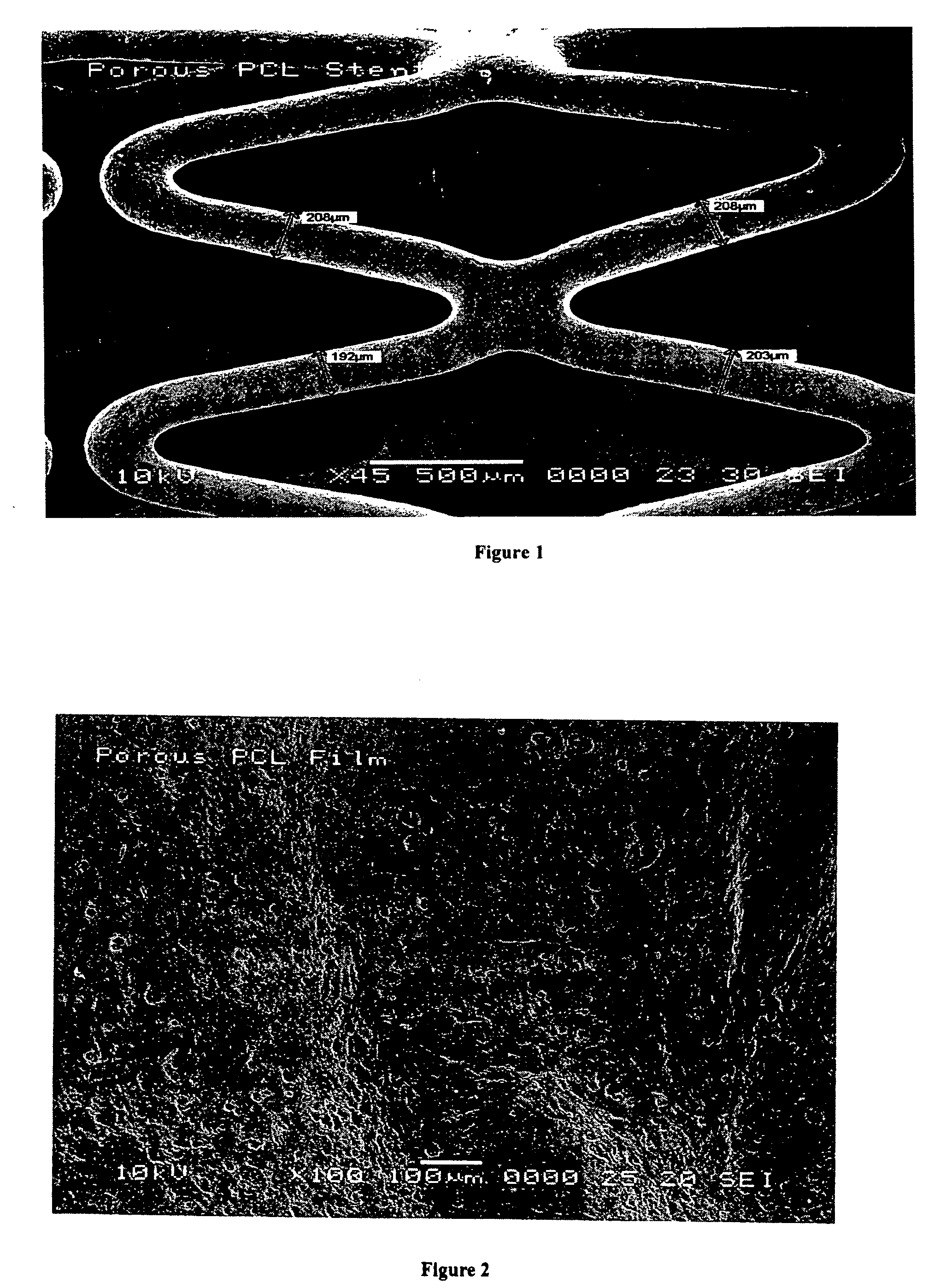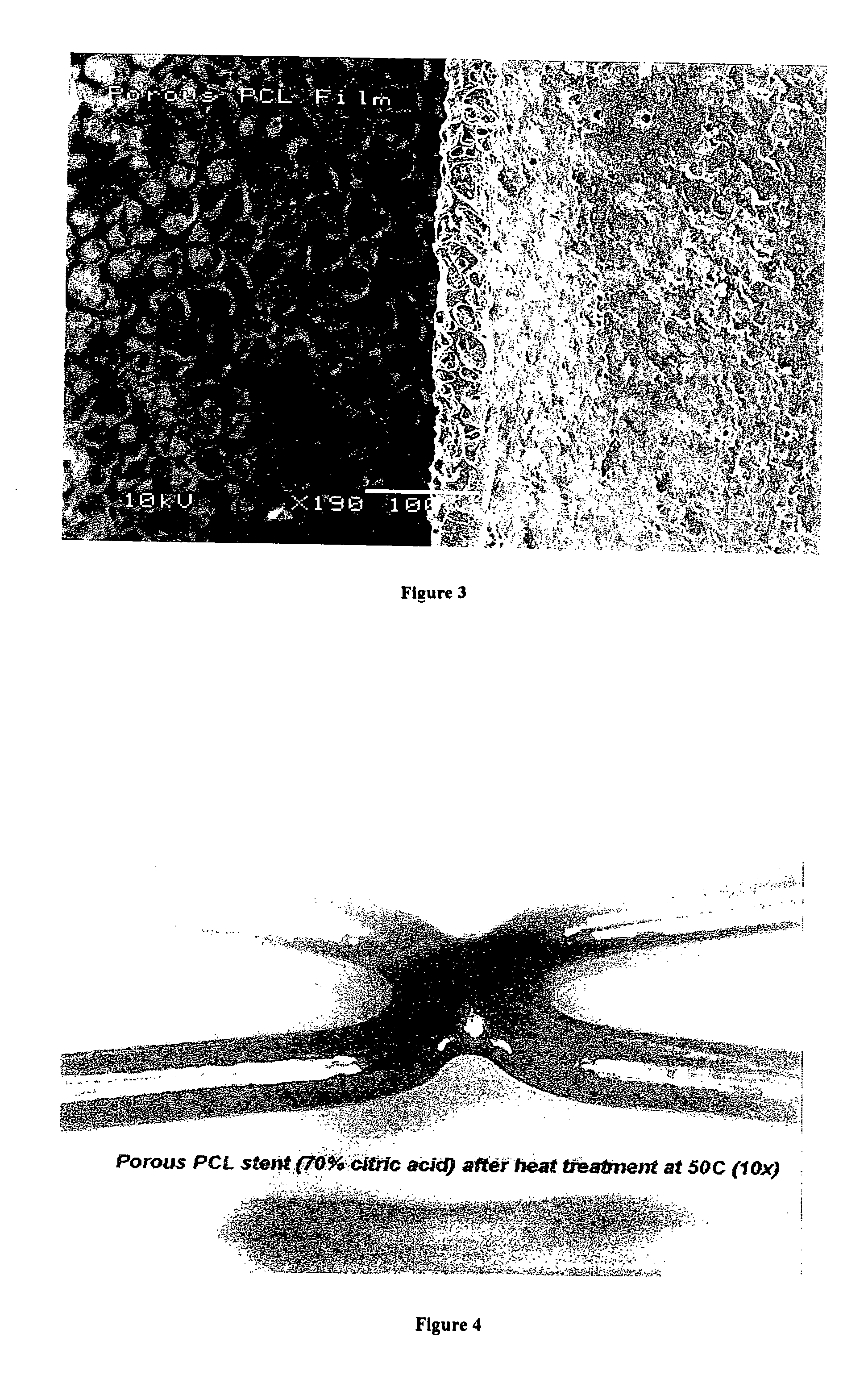Medical device having a surface including a biologically active agent therein, and methods
a technology of biological active agents and medical devices, which is applied in the direction of prosthesis, catheters, peptide/protein ingredients, etc., can solve the problems that known medical devices are often difficult to fabricate, and achieve the effect of reducing the size of surface pores and eliminating porosity
- Summary
- Abstract
- Description
- Claims
- Application Information
AI Technical Summary
Benefits of technology
Problems solved by technology
Method used
Image
Examples
example 1
Preparation of Stents Coated With Porous Polycaprolactone (PCL)
[0061] Stainless steel stents were twice cleaned in isopropanol (IPA) for 30 minutes each using an ultrasonic cleaner. The stents were then air dried and weighed. Stents were then sprayed with a thin coating of 2% by weight solution of PCL in THF to a coating weight of about 70-80 micrograms per stent using an ultrasonic sprayer. The coated stents were then annealed at 70° C. in an oven for about 0.5 hour to provide a stronger interface between the surface of the stainless steel stent and the PCL coating layer. The stronger interface may allow for better adhesion of subsequent layers of polymers sprayed onto the stent. After annealing, the stents were reweighed.
[0062] The coated surface of a stent was then sprayed with a 2% solution of 70% citric acid / 30% PCL w / w in tetrahydrofuran (THF). The total mass of the dried coating was about 4 mg including the citric acid. The citric acid was then removed from the PCL layer by...
example 2
Heat Treatment or Heat Encapsulation of the Porous PCL Stent
[0063] A porous PCL coated stent, prepared as in Example 1, was placed inside a clean glass vial, which was then heat treated by placing inside an oven at 50-55° C. for about 0.5 hour. The heat treatment collapsed the porous structure observed in FIG. 1. If a drug is present within the pores, it will be encapsulated within the polymer matrix. The polymer coating looked smooth and uniform after heat encapsulation without a drug present. After heat encapsulation, the coating thickness was reduced to a very thin coating that was estimated to be a few micrometers. A heat encapsulated PCL coated stent with no drug present is shown in FIG. 4.
example 3
Preparation of Stents Coated With Porous poly(lactide-co-glycolide) (PLGA).
[0064] Stainless steel stents were twice cleaned in isopropanol (IPA) for 30 minutes each using an ultrasonic cleaner. The stents were then air dried and weighed. Stents were then sprayed with a thin coating of a 2% solution of PLGA (50 / 50) in THF (w / w) to a coating weight of about 50-70 micrograms per stent using an ultrasonic sprayer. The stents were then annealed at 70° C. in an oven for about 0.5 hour to provide a stronger interface between the surface of the stainless steel stent and the PLGA coating layer. The stronger interface may allow for better adhesion of subsequent layers of polymers sprayed onto the stent. After annealing, the stents were reweighed.
[0065] The coated surface of a stent was then sprayed with a 2% solution of PLGA(50 / 50) / Citric acid in THF (70% citric acid / 30% PLGA w / w). The total mass of the dried coating was about 4 mg including the citric acid. The citric acid was then removed...
PUM
| Property | Measurement | Unit |
|---|---|---|
| temperature | aaaaa | aaaaa |
| Tg | aaaaa | aaaaa |
| weight | aaaaa | aaaaa |
Abstract
Description
Claims
Application Information
 Login to View More
Login to View More - R&D
- Intellectual Property
- Life Sciences
- Materials
- Tech Scout
- Unparalleled Data Quality
- Higher Quality Content
- 60% Fewer Hallucinations
Browse by: Latest US Patents, China's latest patents, Technical Efficacy Thesaurus, Application Domain, Technology Topic, Popular Technical Reports.
© 2025 PatSnap. All rights reserved.Legal|Privacy policy|Modern Slavery Act Transparency Statement|Sitemap|About US| Contact US: help@patsnap.com



